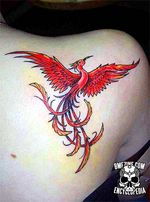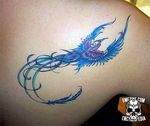Bird of Paradise
The bird of paradise is a common tattoo design motif in a variety of cultures, although it does not have a specific symbolic or metaphorical meaning (other than what bird of paradise naturally implies—keep reading). Unlike the phoenix, it is a real animal (of the family Paradisaeidae) from the New Guinea area. The male, which is almost universally pictured in tattoos, has characteristic extravagant plumage and long-feathered tails:
While one might assume that the bird gets its name from its dramatic feathers, taking a closer look at the tattoos above and noting the lack of legs gives you a better insight as to the source of the name. Native taxidermists in New Guinea prepared the birds for trading by cutting off their legs to dry the skin over a fire. Islamic traders who brought the stuffed birds to Europe played up a legend[1] of ethereal birds who "lack feet and are therefore obliged to fly continuously and live in the highest sky, requiring no food or drink than dew from Heaven."
Thus the name "bird of paradise", and the implied poetic meaning of the tattoo.
Notes
- ↑ Quoted in Crossing Over: Where Art and Science Meet by Stephen Jay Gould and Rosamond Wolff Purcell.

